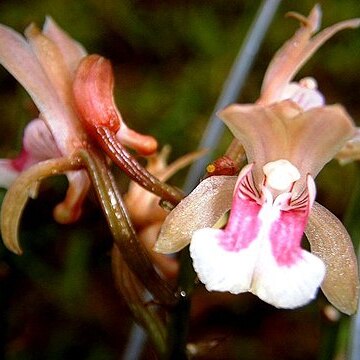Herbs, terrestrial (rarely on rocks or epiphytic), erect. Stems modified into pseudobulbs, often densely congested, concealed by overlapping fibrous sheaths, 1[–3]-leaved. Leaves persistent; blade not imbricate or plicate, usually leathery, often patterned. Inflorescences lateral, arising from base of pseudobulb, racemes or panicles, erect. Flowers resupinate, inconspicuous; sepals and petals distinct and free, spreading; lip deeply 3-lobed, base spurred; column erect, curved, produced into conspicuous foot, oblique at base; anther terminal, operculate; pollinia 2, with short or aborted caudicles attached directly to viscidium. Fruits capsules.
Terrestrial orchids, deciduous or evergreen, with above-ground pseudobulbs and coarse roots. Leaves paired on apex of pseudobulb, distinctly petiolate, each with a broad, plicate blade that is folded together lengthwise in bud. Inflorescence racemose, slender, wiry, arising from a basal node. Flowers with petals smaller than sepals. Labellum attached to anterior base of column. Labellum lamina 3-lobed, short basal pouch, 2 fleshy ridges on basal surface.
Lip spurred, 3-lobed, the mid-lobe usually 2-lobed or emarginate so that the lip appears 4-lobed; disk either with 2 quadrate or triangular calli at the mouth of the spur or with 3 variously thickened, parallel ridges which, together with the lateral veins, are sparsely but distinctly papillose or hirsute.
Column erect, rather short, oblique at the base; anther cucullate or cristate; pollinia 2, ovoid or pyriform, on a short or rudimentary stipes; viscidium large; stigmata confluent; rostellum short.
Leaves coriaceous, conduplicate, not plicate, often variegated, usually petiolate with the petiole articulate above the base.
Sepals and petals free, variously spreading, subsimilar, the petals usually shorter and broader than the sepals.
Inflorescences arising from base of the pseudobulb, simple or branched, several-to many-flowered.
Pseudobulbs set close together, heteroblastic, ovoid to fusiform, 1–3-leaved at the apex.
Flowers resupinate, relatively small, thin-textured.
Terrestrial herbs, rarely epiphytic.

